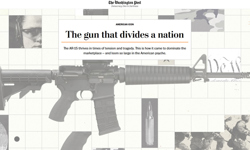Newspaper marketing
The newspaper industry might care, but it doesn’t do much to share. Marketing groups come and go at each title, but there’s little to bond them together in the face of today’s particular enemy: online classified / time poverty / blogs / free magazines (*delete where appropriate).
On the other side of the fence, the big spending advertisers (who, whisper it, pay the wages) are queuing up to not only experiment with different approaches, but also share their experiences.
And one of the biggest spending of all, Procter & Gamble, is boldly going where no British newspaper marketer would dare go by laying open its strategies and inviting both comment and collaboration.
Jim Stengel, P&G’s global marketing officer, told the American Association of Advertising Agencies (AAAA) just what he thought, in a presentation called, somewhat generally, ‘The Future of Marketing’.
So, what can our newspapers learn from the P&G approach? These are Stengel’s main lessons, with some suggestions:
Holistic marketing
* Lesson – Consumers today are less responsive to traditional media. They are embracing new technologies that empower them with more control over how and when they are marketed to. They are making more purchase decisions in environments where marketers have less direct influence, such as in-store, word-of-mouth and professional recommendations.
* Verdict – Newspapers are still woefully unimaginative. Yes, websites are getting better and the Telegraph is having a good crack at podcasting, but the ink on paper approach still dominates. By using old-fashioned word-of-mouth and new-fangled internet techniques, the Arctic Monkeys have taken the music industry by storm. Who’s going to be first with an Arctic Monkeys approach to news?
Permission marketing
* Lesson – All marketing should be permission marketing. All marketing should be so appealing that consumers want us in their lives. We should strive to be invited into consumers’ lives and homes. For each element of the marketing mix, we should ask ourselves, ‘would consumers choose to look at, or listen to this?’, and let that be the benchmark.
* Verdict – Get closer to the readers. Stop viewing them as a passive consumer at the end of the product chain. Invite them to not just feature in the paper, but also be part of the decision making process on what is covered and how it is projected.
Collaboration
* Lesson – Finally, we must collaborate. We’re limited only by our creativity – and by our ability to prove it’s in everyone’s interest to involve advertising in these new media... We may not get another opportunity like this in our lifetime. It’s up to us. Let’s go for it … together. Sometimes, when we’re afraid of change, it’s easier to focus on the smaller issues. There’s too much conflict in the industry today about purchasing, procurement, the pitching process, fees, etc. It’s time to recognize we are part of something much bigger than our individual interests.
* Verdict – Recognise those ‘smaller issues’? Too often, newspapers fiddle around the edges, failing to take opportunities for revolution rather than evolution. Collaboration on content is nil, on marketing and promotion nil. Perhaps it’s time to look at British Newspapers plc as a marketing exercise with readers, non-readers, lapsed readers and occasional readers. Forget about the nonsense of inching up market share and let’s look at growing that total market.
Read Stengel’s speech here.
Tabloid culture
| Circulation performance of the ‘popular’ papers | |||
| Paper | Jan 06 | Jan 05 | %change |
| The Sun | 3,319,237 | 3,328,409 | -0.28 |
| Daily Mirror | 1,727,672 | 1,748,372 | -1.18 |
| Daily Star | 819,431 | 861,208 | -4.85 |
| Daily Sport | Unaudited, but Sunday Sport 143,506 | ||
| *Source ABC | |||
Britain’s racy tabloids continue to defy the wisdom that the reader wants to learn more about the world around them, and play a bigger and better part in it.
The four titles that cover the country sell the thick end of six million copies a day, trading, unashamedly, on the lives of the rich, the famous and infamous. Not a lot there on self-improvement or how to provide a better life for our children.
These ‘popular’ papers far outsell the ‘quality’ papers, with their DVD language courses and cookery series – so what’s the secret?
Travel 900 miles east from London to Poland and there are a few clues. Axel Springer, publisher of Germany’s Bild Zeitung, picked up their successful model of celebrity news, right-leaning politics, sport, sex, crime and horoscopes and plonked it down in the middle of a strict Catholic country.
Within two years, it’s selling half a million copies a day and is the biggest selling newspaper in the country. Much hand-wringing at Gazeta Wyborcza, the former leading daily, which began as Solidarity’s underground newspaper in the run-up to the communist overthrow in 1989.
It’s a serious paper in a country of serious people, where the pain of communist rule is never far below the surface. But Fakt junked those notions and came in with a racy, almost frivolous, approach which struck a nerve with a population emerging from years of dismal ‘read this because it’s good for you’ publications.
Now, Axel Springer is thought to be eyeing Russia, where an immature ‘free’ newspaper market is still struggling with how to engage a readership that has no history of choosing what to read. Komsomolskaya Pravda, the biggest circulating paper in Russia, which has a population about three times Britain’s, sells just 800,000 – about the same as the Daily Express.
Our popular papers have had far longer to hone their products, but the relative success of the news-light Daily Star and Daily Sport might even indicate to Springer that there’s room for them over here. Now, that would shake a few cobwebs out of the corners…
What your front page says about you
A regular view on how a front page says more than you think about a title. This issue: the red top dailies.
Daily Mirror
Price: 38p, 80 pages.
Tagline: A BETTER READ..GUARANTEED
Puffery: Phone camera quality pictures of ‘Cameron’ and ‘Jude’ (no, not David and The Obscure) tempting readers to the 3am spread on pages 16 & 17.
Come-ons: Bizarre picture of a woman with a book on her head – ‘Get the perfect posture’ – referring to Your Life, a confusing run-of-paper section stuck between news and TV.
Content: Celebrity nonsense (Scarlett, X Factor Shayne, Kate, Robbie etc) sitting alongside ‘proper’ news, politics, fashion, telly and columnists. Lots of sport.
Positioning: The de-politization of Britain has left the Mirror floundering for a new constituency of readers. Gone are the factory workers, miners and pigeon fanciers on whom the Mirror made its name. Still solidly left-wing, but as any kind of political stance becomes increasingly irrelevant, so does the Daily Mirror.
Inside word: Journalists keep as much of an eye on the share price as they do the headlines. Rumours of Trinity Mirror’s sale are not always that exaggerated. It will come one day, and with it the shackles of shareholder return could be released allowing the Mirror to return to the glory days of campaigning journalism.
The Sun
Price: 35p, 88 pages.
Tagline: None, but www.thesun.co.uk prominent under masthead.
Puffery: Tiny promo for ‘20% off Fisher-Price at Mothercare’ and similarly small waste of space teaser to Sunsport. It’s got its own front page (the back page) and doesn’t need a cross-ref.
Come-ons: Big picture of Jessie (Wallace not Jackson) in happier times referring to an ‘exclusive’ on page 7.
Content: Right hand pages celebs (Kate, Chantelle, Barbara Windsor), left hand pages ‘news’ (Blair/Brown, Saddam, bird flu). Plenty to read, with news up to page 29, followed by telly and sport.
Positioning: Consistently low-brow, but 3,319,237 buyers a day can’t be wrong. Just two bare breasts (page 3, of course). Trevor Kavanagh’s political column complements the ever-pithy leader column.
Inside word: Still the best journalism in Britain (yes, really) with beautifully crafted words, but the design is beginning to look tired. Black and white pages don’t help in this colourful age. Lots of loyal readers who won’t all be rushing to the internet for news and entertainment although thesun.co.uk is already one of the most popular media sites in the country (look out guardianunlimited).
Daily Star
Price: 30p, 72 pages.
Tagline: BECAUSE OLD GOSSIP IS NO GOSSIP
Puffery: A big yellow 30p, and almost unbelievably, the paper costs 30p.
Come-ons: Nothing to win or have for free. Big picture of Abi (Titmuss not Ofarim) teasing to exclusive spread on page 19. Well-crafted picture and headline panel referring inside to the heist latest.
Content: A fairly predictable celeb menu, but there’s enough on offer to satisfy most, not particularly fussy, tastes. Some serious news, but not always as we’d know it, and lots of TV and sport.
Positioning: There’s a definite feel of the f-word here, yes fun. Headlines are by turn cute (‘On mein head son!’) and easy to follow (‘Race riot fear at Hamza’s jail’) and nobody seems to take themselves too seriously.
Inside word: At turn the bastard child and favourite son of successive owners but now firmly positioned almost on its own among the tabloids. Never a challenging read, but always on the mark, the Daily Star will continue to be more than a nuisance to the two big boys.
Daily Sport
Price: 45p, 56 pages.
Tagline: BRITAIN’S FUNNIEST PAPER
Puffery: 15p in zillion point. Not that the paper is 15p, just that it’s 15p ‘cheaper than some others’ despite the fact that no national paper in the UK costs 60p.
Come-ons: Lots of flesh, but no nipples; a concession to the newstrade who would otherwise refuse to display the paper alongside other daily titles.
Content: Bare flesh and plenty of it, some short ‘news’ stories and lots and lots of sleazy ads.
Positioning: Difficult to see who would actually buy this apart from depraved loners or lads who like to titter at the tea break. It’s too rude to have in an office and could only really survive in a male environment.
Inside word: For what it is, the Daily Sport is a well produced, professional product. It must make oodles of money from the ads, and although there aren’t many readers, who cares? Don’t expect it to be going anywhere soon.










